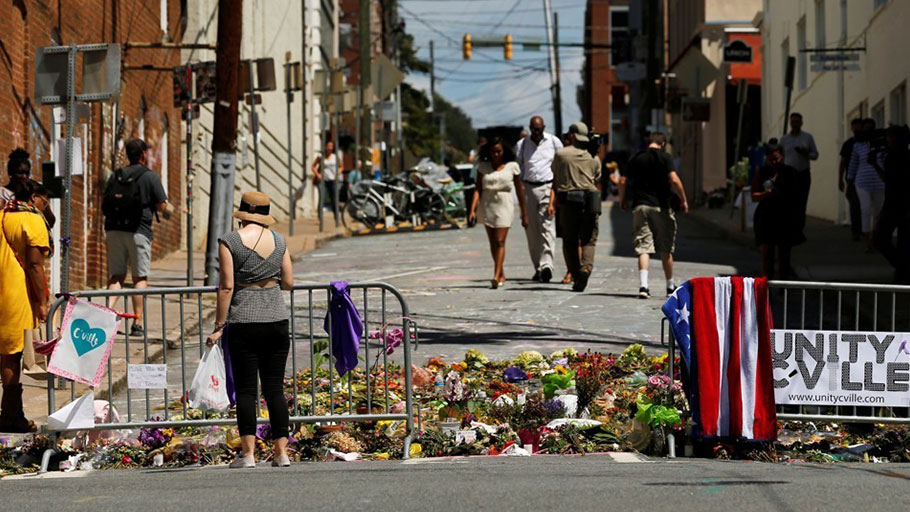A new report finds that white supremacists committed the largest share of domestic-extremist related killings last year—highlighting the danger of racist rhetoric and hateful ideas.
Although the leaders of the white-supremacist alt-right insist their movement is nonviolent, racist rhetoric and hateful ideas can inspire violence if taken to their logical conclusion. A lone individual, encountering white-supremacist propaganda, can become convinced that it is a cause worth fighting for. Timothy McVeigh read The Turner Diaries, a story of a race war written by a notorious white supremacist, before he carried out the Oklahoma City bombings. Dylann Storm Roof frequented racist and anti-Semitic sites before he walked into an African American church and gunned down nine parishioners in Charleston, South Carolina.
And the threat they pose is not trivial. According to the latest data from Anti-Defamation League’s Center on Extremism, white supremacists were responsible for more than half of the 34 fatalities linked to domestic extremists of all stripes last year, claiming 18 lives in 2017.
That represented a reversion to the long-term trend; right-wing violence had accounted for the largest share of domestic-extremist related killings every year from 1995 until the Pulse nightclub shootings in 2016. Global totals may tell a very different story, but in the United States far-right extremist murders far exceed those carried out by Islamic extremists over the last decade: 71 percent of all murders were carried out by right-wing extremists, and 26 percent can be linked to Islamic extremists.
Two deadly shootings at the end of 2017 reinforced how the well-worn path from hate speech to action leads certain individuals to resort to lethal violence.
In Reston, Virginia, a teenager who allegedly absorbed neo-Nazi ideology online has been charged with shooting and killing his girlfriend’s parents in a tragic double homicide. The young man allegedly committed the murders after learning that the parents had convinced their daughter to break up with him because of his purported racist views.
There were warning signs: On Twitter, the teenager allegedly retweeted messages praising Hitler, posted derogatory remarks about Jews, and called for a “white revolution.” He is also believed to have mowed a 40-foot swastika into the grass at a local park, The Washington Post reported.
This horrific attack came barely a week after a 21-year-old man in New Mexico who, The Daily Beast reported, frequented white-supremacist websites went on a shooting rampage at a local high school, murdering two students before taking his own life.
While it is impossible to draw a direct line of causation between these brutal acts and the many public displays of white supremacy that took place around the country in 2017, it’s critical not to underestimate the effect of an increasingly visible alt-right and white-supremacist community on people who are already predisposed to racism.
The “Unite the Right” rally in Charlottesville last August was a watershed moment for the white-supremacist movement. The event clearly demonstrated the ability of a fringe movement to captivate the nation’s attention with vitriol and deadly violence. The racist gathering turned the debate over the removal of Confederate monuments into a confrontation—and sparked a national conversation about racism that will continue well past 2018.
That event itself also inspired lethal violence: A participant at the rally allegedly drove his car into a crowd of counter-protesters, killing activist Heather Heyer and injuring nearly a dozen people.
But Charlottesville was just one marker of a larger, problematic trend: From the distribution of white-supremacist propaganda on campuses, to dozens of rallies and demonstrations, white-supremacist activism was visible across the country in 2017, signaling a new willingness by racist groups to put themselves front and center on the American public stage.
A closer look at white-supremacist beliefs helps to shed light on why this upsurge is happening.
Modern white-supremacist ideology is founded on the belief that white people are on the verge of extinction, thanks to a “rising tide” of non-white populations (supposedly controlled by a Jewish conspiracy). As a result, some white supremacists and other racists justify their actions as attempts to “save” their race. When they say the white race is being threatened with “genocide” or “extinction,” it becomes easier for them to justify or rationalize violence in the name of “preserving” the race.
Take William Atchison, the alleged perpetrator of the Aztec, New Mexico, high school shooting. Atchison fantasized about killing Jews, taking screenshots of video games like Grand Theft Auto in which he was targeting people who were identifiably Jewish. He admitted to posting on the white-supremacist website The Daily Stormer, as well as on the controversial message board 4chan. For Atchison, the next logical step was taking those fantasies out of the virtual realm and into the real world.
Or take Taylor Michael Wilson, who on October 22 allegedly breached a secure area of an Amtrak train as it passed through Nebraska and pulled the emergency break: He was armed with a gun and carrying business cards from the National Socialist Movement. Wilson, who had participated in the rally in Charlottesville, had a stash of more than 20 weapons at his house. A family member said that Wilson was “serious about killing black people,” according to an FBI affidavit filed in the case. He’s now charged with terrorism.
In March, James Jackson allegedly traveled from Maryland to New York City to attack African American men in an alleged effort to discourage interracial relationships. That same month, a grand jury indicted a South Carolina man on firearms charges after he reportedly discussed plans for “an attack on non-whites.” And in October, three Texas men were arrested in Gainesville, Florida, for allegedly firing into a group of people following a campus speaking event featuring the alt-right leader Richard Spencer.
If Americans don’t take action to directly address the threat posed by those who traffic in racism and hatred, they shouldn’t be surprised by the next white-supremacist killing. This is why ADL supports federal and state programs to counter all forms of violent extremism and advocates for enhanced penalties for those who commit hate crimes.
In recent years, much of the public discussion and the federal government’s focus have been on the violent threat posed by extremists inspired by ISIS, while less attention has been paid to the reality of right-wing violence. There’s no doubt that Islamic extremism is a significant threat, but we shouldn’t ignore any forms of extremism—we must tackle them all.
In this climate of emboldened haters and bigots, there’s no alternative but to expose and publicly reject their message, to send it back into the shadows where it, and its adherents, truly belong.















